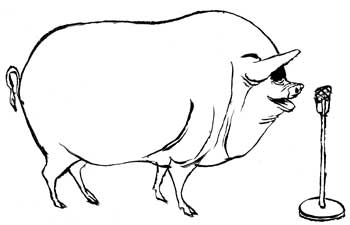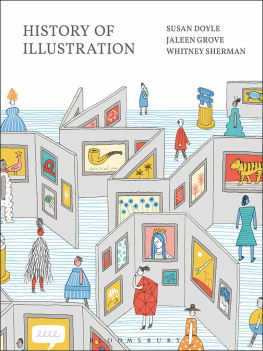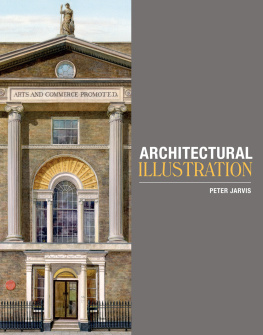Teaching
Illustration
Steven Heller
and Marshall Arisman
Course Offerings and Class Projects
from the Leading Undergraduate
and Graduate Programs

2006 Steven Heller and Marshall Arisman
All rights reserved. Copyright under Berne Copyright Convention, Universal Copyright Convention, and Pan-American Copyright Convention. No part of this book may be reproduced, stored in a retrieval system, or transmitted in any form, or by any means, electronic, mechanical, photocopying, recording, or otherwise, without prior permission of the publisher.
10 09 08 07 06 5 4 3 2 1
Published by Allworth Press
An imprint of Allworth Communications, Inc.
10 East 23rd Street, New York, NY 10010
Cover and interior design by James Victore
Typography/page composition by SR Desktop Services, Ridge, NY
ISBN-13: 978-1-58115-466-5
ISBN-10: 1-58115-466-6
ISBN: 9781581158267
Library of Congress Cataloging-in-Publication Data
Teaching illustration: course offerings and class projects from the leading undergraduate and graduate programs/[edited by] Steven Heller and Marshall Arisman.
p. cm.
Includes bibliographical references and index.
ISBN-13: 978-1-58115-466-5 (pbk.)
ISBN-10: 1-58115-466-6 (pbk.)
1. Commercial artStudy and teaching (Higher)United States. 2. Commercial artStudy and teaching (Graduate)United States. 3. Universities and colleges CurriculaUnited States. I. Heller, Steven. II. Arisman, Marshall.
NC1000.T42 2006
741.6071173dc22
2006035208
Printed in Canada
To David Rhodes, President of the School of Visual Arts

T eaching is not a lost art, but the regard for it is a lost tradition.
Jacques Barzun, Teacher in America (1944)

N o generation is interested in art in quite
the same way as any other; each generation,
like each individual, brings to the contemplation
of art its own categories of appreciation, makes its own
demands upon art, and has its own uses for art.
T. S. Eliot, The Use of Poetry and the Use of Criticism (1933)
a
acknowledgments
Thanks to Kim Ablondi, without whose tireless support this book would not be possible. You are a saint.
Our friends at Allworth Press also earned their place in heaven. Thanks to Monica Lugo, associate editor, for her invaluable editing and molding of this unwieldy manuscript. Our gratitude to Michael Madole, Gebrina Roberts, Cynthia Rivelli, and Bob Porter for their hard work on our behalf. And to Tad Crawford, publisher, for his continued faith in our projects.
Of course, all the contributors must be commended for their fine syllabi, but also for their dedication to illustration and education.
Finally, thanks to James Victore for his cover and interior design schemes, and to Susan Ramundo for her fine production work.
SH and MA

N ever try to teach a pig to sing ...
it wastes your time and annoys the pig.
Anonymous, Texas Saying
f
foreword
Can Illustration be Taught? Are Illustrators Teachable?
Dont be misled by the title of this foreword. Illustration can most definitely be taught. After teaching at the School of Visual Arts for almost forty years, my coeditor Marshall Arisman would be a fool to say otherwise. Whats more, his School of Visual Arts MFA Illustration program has turned out its fair share of successful illustrators, proving that some practitioners are indeed extremely teachable. So, if the readers of this text thought I was throwing myself into a hornets nest with such provocative introductory questions, rest assured Im convinced the tenets and techniques of illustration are routinely passed on from teacher to student. Nevertheless, an important question remains: How does this occur?
Some pedagogical issues have been more or less standardized, yet no textbook (save for those so-called applied art instructional guides found on bookstore how-to shelves) exists to steer the erstwhile illustration teacher in the right direction. Of course, tried-and-true programs in drawing and painting (even in three dimensions) can be found in most art schools catering to illustration majors, but few schools teach the exact courses at the same pace or levels. Despite basic curriculum requirements, illustration coursework is usually a function of the respective teachers interests, passions, and expertise rather than dictates from an illustration academy. Since undergraduate illustration programs are an academic netherworldoften cobbled together from classes that are part art and part craft, with a little commerce thrown in for good measureteaching is sometimes catch-as-catch-can depending on the intensity of the program, and students suffer the consequences.
Another problem, however, lies in the fact that a large percentage of students enrolled in illustration programs really have no idea what illustration actually is (and I include seniors in this assessment). Since it is a commercial discipline, parents dont have the same qualms about allowing their children to go to college for illustration as they do about the more ethereal fine arts. Yet many students become illustration majors not because they want to make livings doing editorial, advertising, or childrens books, but because it allows them a chance to make art. Many illustration classes are so art oriented that the distinction between fine and applied is virtually obliterated.
Of course, theoretically the basic principles of art universally applygood illustration should be good artbut since the motives and outcomes are quite different there is often an evaluative contradiction. Generally, fine art is more about form than content; illustration is more about content (and style) than form (although the two should intersect). Students are, therefore, often confused by courses that emphasize free expression over the rigors of problem solving, and unless they are committed to becoming serious illustrators they find it rather difficult to adjust to the strictures of the illustration field. While visiting a class of seniors at a prestigious art school, I asked how many of them, upon graduation, wanted to pursue the illustration profession? Out of forty students, only two raised their handsand one of them wanted to make graphic novels and comic animationwhile the rest were nervously uncertain.
Is this profound lack of interest a failure of education? Or is it endemic to the education process?
Arguably, most undergraduates in all disciplines are unsure about their career paths, and only a few actually follow their majors into the workplace. The increase in graduate enrollment attests to the fact that an undergrad degree is not the end but the beginning. While illustration programs seem to focus on a narrow career path, students may nonetheless fulfill their degree requirements only to find they are not suited for illustration. Like English or sociology programs in liberal arts schools, illustration may be one of those allencompassing art school majors whereby students are introduced to a potpourri of crafts and skills that may or may not benefit them later. But when I spoke with those forty students, I found honest concern that after three years they werent prepared to meet the world. Some suggested that as hard and rewarding as their coursework was, they were unclear what to do next (I dont want to draw pictures for magazines, said one anxious female student, do you think maybe I should study art therapy?).
Next page
















